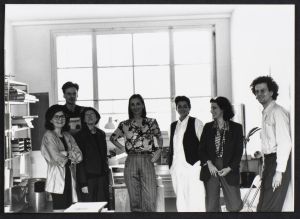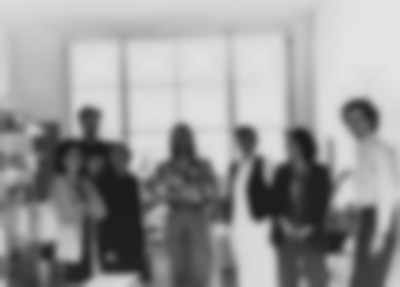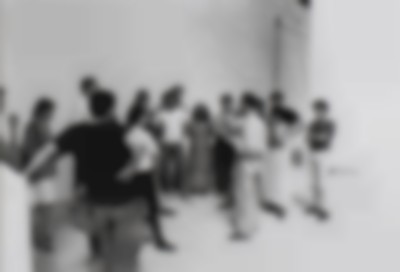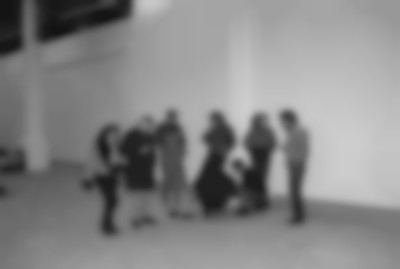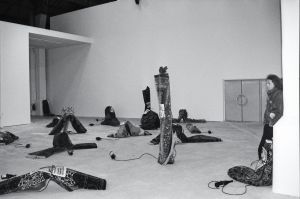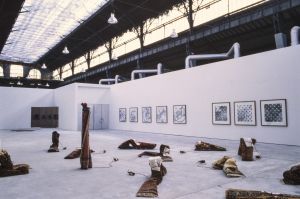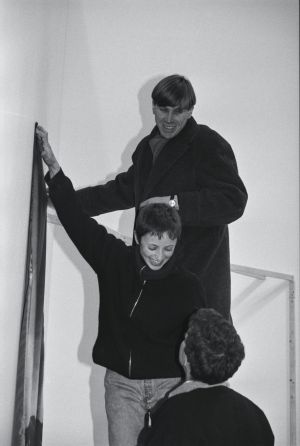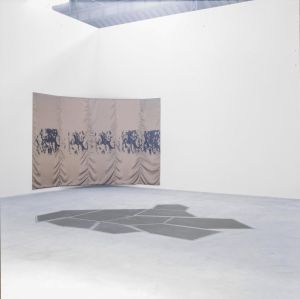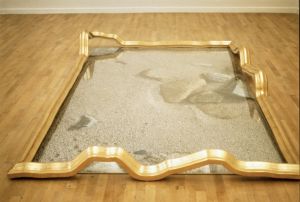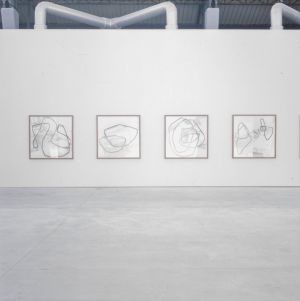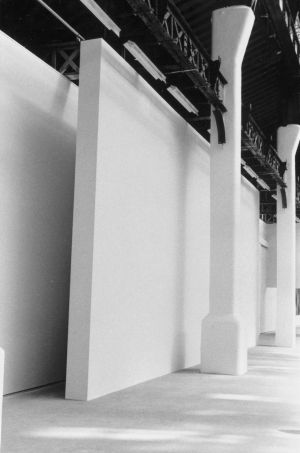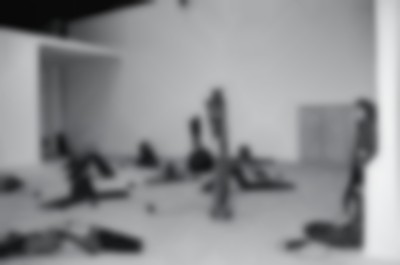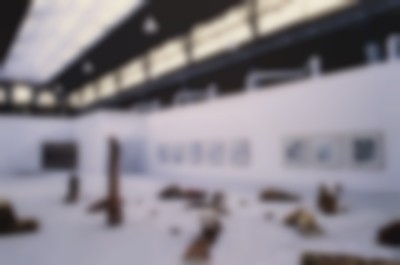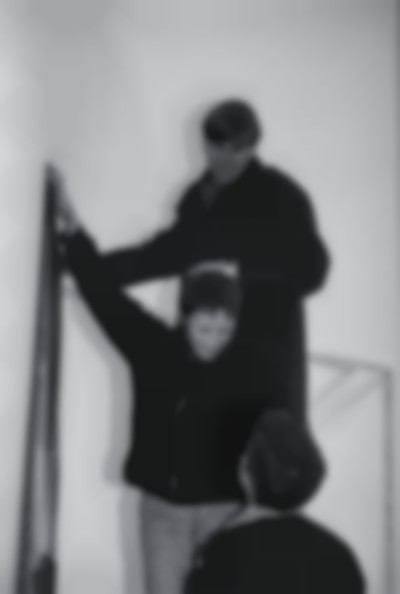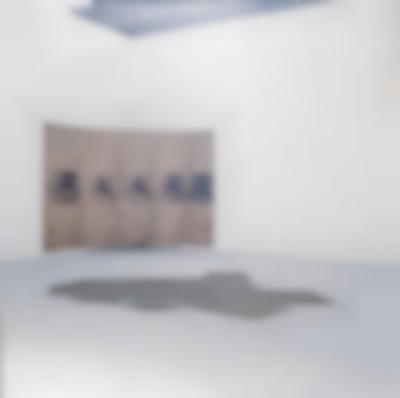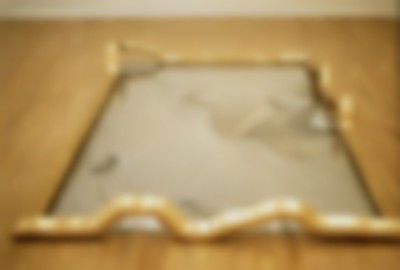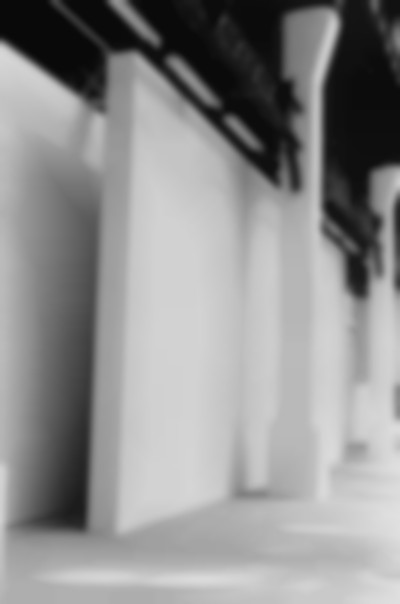Session 3: presentation
| Session | 3 (1990–1991) |
|---|---|
| Participants |
Annick Doherty |
| Direction |
Adelina von Furstenberg |
| Session website | – |
| Coordination | – |
| Tutoring | – |
| Educational team | – |
| People met |
Vito Aconcci (artist) |
| Travels |
Lyon, Villeurbanne, Saint-Étienne, Firminy, Péage-de-Roussillon, Paris, Givors, Venise, Florence, Turin, Geneva, Berne, Schaffhausen, Zürich, Bâle, Strasbourg, Francfort, Darmstadt, Bonn, Cologne, Düsseldorf, Mönchengladbach, Eindhoven, Amsterdam, La Haye, Rotterdam, Antwerpen, Bruges, Gand, Temse, Chagny, Barcelona, Madrid, Valencia, Milan, Volpaia, Brussels |
Related archive
L’exposition de l’École du Magasin
| Project |
L’exposition de l’École du Magasin |
|---|---|
| Presentation |
The prelude to the exhibition basically had two themes. The first was a discussion about exhibitions and artists studios that we visited as a group. It was a debate on works and artistic attitudes where different points of view met, ranging from relatively objective observations to more subjective matters of taste. The second was a discussion on three main ideas: painting seen as an enlarged concept that can encompass other disciplines, the resistancefactor of an art work and, thirdly, the notion of the private and public aspects of an art work. These ideas have a rich history, the concepts of resistance and the private and public being particularly related to important moments in art history. The idea of painting as an enlarged concept, as we see it, is however more directly linked with the current attitude of the artist-painter. […] |
| Format |
Collective exhibition |
| Date |
16 February – 31 March 1991 |
| Location |
La Rue, Magasin-CNAC |
| With |
Michel Aubry |
Entretien avec Grazia Quaroni
Entretien avec Grazia Quaroni
par Michela Alessandrinii
30.05.2018
Michela Alessandrini : Pouvez-vous présenter et me parler brièvement de votre parcours avant l’École, ainsi que des raisons qui vous ont poussé à postuler à cette formation ?
Grazia Quaroni : Je m’appelle Grazia Quaroni et je travaille à Paris à la Fondation Cartier pour l’art contemporain, où je dirige la collection. J’ai fréquenté l’École du Magasin en 1990-1991 (Session 3). J’étais la première italienne à avoir accès à cette formation que j’ai connue par pur hasard au fil de discussions avec mes collègues à Milan, où je suis née et où je travaillais à l’époque. Après une formation classique en lettres modernes et histoire de l’art, et déjà pendant mes études, je me suis tournée vers la question du musée. J’avais choisi le champ de l’art contemporain comme mon terrain de travail. Mes professeurs, qui étaient des critiques d’art notamment, m’avaient guidé dans des questions comme la relation entre l’œuvre et l’espace. La charge symbolique de l’espace d’exposition m’intéressait particulièrement. À cette époque on avait un vocabulaire différent : on commençait tout juste à parler de curateur, et le critique d’art était la véritable profession dans le domaine de l’art contemporain, alors qu’aujourd’hui « critique d’art » sonne presque comme un gros mot par rapport à il y a trente ans. J’avais donc décidé de vouloir travailler dans une institution muséale, publique ou privée, peu importe. J’aimais écrire mais seulement en complément d’un travail sur le terrain et j’avais trouvé deux formations possibles pour poursuivre cet intérêt : celle du Whitney Museum à New York, et l’École du Magasin. J’ai tenté la première sans succès, donc quand j’ai eu connaissance de l’École du Magasin, j’ai essayé et là ça a marché.
MA : Donc on pourrait dire que vos attentes étaient surtout pédagogiques : il y avait une nécessité d’apprendre sur le terrain, de saisir ce métier et ses outils.
GQ : C’était une période d’apprentissage : j’ai toujours considéré l’École du Magasin comme un lieu pour la réflexion, un moment privilégié qui ne revient plus dans une vie, dès qu’on commence à s’investir dans un métier. Ce moment de réflexion quotidienne est resté unique dans ma vie. On était là pour s’interroger sur le rôle du curateur car on ne savait pas exactement à quoi correspondait ce métier et quelles étaient ses limites, notamment par rapport au métier de critique d’art. On parlait du curateur comme d’une figure créative depuis une vingtaine d’années, mais c’était quelque chose de nouveau dans le système de l’art en général. Les deux côtés qui le constituaient (celui intellectuel de l’écriture et celui pratique de l’organisation) correspondaient à mes caractéristiques professionnelles et également à la double nature de l’œuvre (spirituelle et physique). De plus, il fallait transmettre au public. La question était comment montrer et pourquoi.
MA : Vous aviez l’impression que cela était une envie partagée aussi par les autres participants et par l’institution ?
GQ : Le fonctionnement du centre d’art tenait compte de cette problématique muséographique et muséologique. La question de la relation du commissaire et de l’artiste, ainsi que de l’articulation de l’œuvre dans l’espace – qui plus est, aussi spectaculaire et contraignant que celui du Magasin – était posée clairement par l’institution. Quant à mes camarades, chacun avait orienté ses réflexions d’une façon personnelle et originale. Chacun avait un champ d’intérêt un peu déplacé, dans le même prisme qui était la réflexion sur l’œuvre, l’artiste et le commissaire d’exposition. Les horizons étaient très différents, les nationalités aussi… c’était peut-être la première année qu’il y avait autant de nationalités dans une même session.
MA : Est-ce qu’à votre avis cela pouvait être dû au fait que la direction du Magasin était assurée par Adelina von Fürstenberg ?
GQ : Je crois que son cosmopolitisme a sûrement joué un rôle important, tout à fait. Le programme a toujours été ouvert à l’internationale, mais sous la direction de Jacques Guillot les sessions de l’École étaient principalement composées de français, ce qui paraît logique pour une institution débutante. Adelina avait déjà à ce moment-là un parcours exceptionnellement varié, et je crois que ça a donné une impulsion importante au choix des participants en terme de nationalités extra-françaises.
MA : Dans son entretien, Adelina insiste beaucoup sur le côté pratique et participatif de la formation comme étant central. Il était avant tout question de développer le métier sur le terrain, que les étudiants puissent sortir de l’École pour aller à la rencontre des professionnels, non pas pour établir un carnet d’adresses mais pour apprendre le métier dans ses aspects les plus pratiques et en tant qu’expérience collective.
GQ : Effectivement, la première claque que nous avons reçue en arrivant au Magasin a été de se confronter avec le « vrai » travail. Moi j’étais une académicienne on ne peut pas plus classique, et j’avais eu très peu d’expériences de cet ordre auparavant, c’est-à-dire prendre en charge tous les aspects liés à l’exposition, de l’organisation du cocktail pour le vernissage au montage, jusqu’à occuper les soirées de l’artiste quand il était à Grenoble. Tout ça était extrêmement enveloppant et nous a réuni autour d’un projet commun, alors qu’à la base mon approche était très individualiste et « souris-rat de bibliothèque », si je peux dire. Se salir les mains dans des activités considérées comme peu intellectuelles a été la fondation de mon métier et a guidé ma carrière. Il y avait aussi une nécessité de travailler en groupe, bien évidemment, de savoir s’accorder, de faire des compromis et de vivre ensemble. Ceci dit, être six curateurs pour une seule exposition m’a paru un peu artificiel. Il y avait une dimension pédagogique certaine, mais c’était sûrement différent par rapport à la réalité du commissariat d’exposition. Faire une exposition à la fin de l’année à l’École du Magasin, alors que le temps nous manquait et que les temps d’une exposition sont souvent plus longs, était un exercice sympathique et valorisant pour nos parcours mais pas très utile à mon sens.
MA : Ce projet de fin d’année consistait en quoi ?
GQ : On n’est pas allés plus loin que la question basique qui est celle de faire une exposition personnelle ou collective : notre réflexion n’était pas située là, en toute honnête. S’il y a une bibliographie sur les pratiques curatoriales aujourd’hui qu’il n’y avait pas à l’époque on le doit aussi au Magasin. Donc on a dû construire cette réflexion, car elle n’existait pas. On devait partir de notre expérience de visiteurs d’expositions ; on a découvert tout ça sur le terrain, et je n’ai pu voir tout ce qui s’était passé auparavant en termes d’histoire des expositions seulement bien plus tard.
Pour revenir à l’exposition de fin d’année, on a donc fini par réaliser une exposition collective, ni originale ni expérimentale : chacun d’entre nous devait présenter plusieurs artistes, et chacun faisait l’objet de discussions interminables dans le groupe. À la fin on en retenu six, il y en avait beaucoup plus au début. On avait la moitié de la « rue » du Magasin à notre disposition, c’était une chance inouïe pour nous.
MA : Est-ce qu’au cours de l’année vous vous avez rencontré ou engagé des personnalités de la région ou de la ville de Grenoble ?
GQ : On avait rencontré tous les artistes locaux ; on avait des relations avec l’école des beaux-arts, aussi bien les étudiants que les professeurs. C’est là que j’ai connu Serge Lemoine, à l’époque Directeur du Musée des Beaux-Arts de Grenoble et ensuite fondateur du D.E.A. (devenu Master 2) L’art contemporain et son exposition, à l’université Sorbonne-Paris 4, précisément axé sur les questions au cœur de l’École du Magasin. Lemoine m’a embauchée des années plus tard pour enseigner dans ce Master et diriger les expositions des étudiants.
MA : Si on devait esquisser le contexte culturel dans lequel vous baigniez…
GQ : Il y avait sans doute une interdisciplinarité (un mot un peu banalisé aujourd’hui) dans l’offre pédagogique. Le Magasin était le centre d’un mouvement plus vaste : il y avait beaucoup de passage de professionnels venant de domaines variés, sans doute grâce aux connections d’Adelina, qu’elle n’hésitait pas à partager. On a vu défiler des cinéastes, des musiciens, des gens qui nous ont exposés à la variété des formes de la création.
MA : Est-ce qu’on pourrait dire que votre emploi du temps était chargé ?
GC : Décidément, je ne me rappelle pas avoir eu une vie en dehors du Magasin pendant dix mois. Par contre ce temps est passé très rapidement. En Italie je n’avais jamais eu accès à cette variété d’institutions pour l’art comme en France avec les FRAC, les DRAC, les centres d’arts, les musées, etc. D’ailleurs en France aussi c’était assez nouveau, car cette décentralisation avait été démarrée peu avant mon arrivée à Grenoble. Donc j’ai dû d’abord comprendre le système local, et ensuite le fonctionnement interne de ces structures, et en même temps m’insérer dans un réseau international. C’était très prenant. J’ai aussi fait mon stage d’un mois dans la rédaction d’Artforum à New York pendant ce temps-là. On appelait ça un stage long, mais il y en avait aussi des courts qui duraient une quinzaine de jours – j’en ai fait un à la Fondation Cartier pour l’art contemporain, en effet. On peut dire que l’École du Magasin m’a donc trouvé du boulot : ce n’était pas la finalité, mais ça pouvait arriver… et ça m’est arrivé.
MA : Vous aviez quel âge à ce moment-là ?
GQ : J’avais 28-29 ans.
MA : Quelles sont les expériences qui ont marqué cette période ?
GQ : La mobilité qu’on avait. Nous n’avions pas vraiment une vie de bureau. Je n’ai jamais passé plus de trois semaines d’affilé à Grenoble, on était tout le temps en voyage. Tout ça avait été possible grâce au réseau de la directrice du Magasin, et aussi grâce au budget conséquent que l’on avait à l’époque pour nos déplacements. C’est vrai qu’on n’était pas là pour se faire un carnet d’adresses, mais certainement pour comprendre qui étaient les acteurs du monde de l’art au niveau international. On a rencontré plein de monde et fait des expériences qu’on n’aurait pas pu faire autrement. On a développé des relations qui sont restées, qui font partie de ma vie désormais, ou qui ont tout simplement laissé une trace importante. C’était humainement et professionnellement très dense. On est allés partout en Europe, surtout dans des endroits où on n’aurait pas eu l’occasion d’aller par la suite. Aujourd’hui on voyage avec légèreté et facilité, alors qu’à l’époque c‘était vraiment une expérience nouvelle. Par contre, oui, on est restés en Occident… L’exposition Magiciens de la Terre avait été inaugurée l’année précédente, il n’y avait pas encore d’ouverture suffisante aux autres continents.
MA : Quels types de liens avez-vous gardés avec l’École du Magasin suite à votre expérience ?
GQ : J’ai gardé des liens très forts avec une partie de ma session. Pendant de longues années, ma session et celles juste avant et après ont été mon réseau premier – quand j’avais besoin d’une adresse ou d’un conseil concernant un autre pays, par exemple. Deux trois sessions après la mienne, une autre génération a démarré. J’ai gardé aussi une relation d’estime et d’amitié profonde avec Adelina. On ne se voit pas souvent, mais je sais qu’elle est là, la forme splendide, prête à reprendre la conversation à tout moment, et à ouvrir les portes de sa maison en cas de besoin ou pour le plaisir de se retrouver. Pour la vie.
Interview with Mark Kremer
Interview with Mark Kremer
by Lore Gablier
30.04.2018
Lore Gablier : To begin, could you briefly introduce yourself and elaborate on your decision to apply for the École du Magasin?
Mark Kremer : I have been working in the art field for 30 years as an art writer, a tutor and curator (mostly free lance). In 1988 I had finished my university studies – art history (major), film history, theatre science, literature science and Italian (minors) – at the UvA in Amsterdam. In the last phase of my studies, I was offered a small job at a platform for experimental video, sound and film in Amsterdam: Time Based Arts. I did this for a year and then I became assistant at Gallery Swart. Riekje Swart was an inspiring personality but after three months I said: Bye bye!” I was searching, eager to join the art world but I didn’t see the way nor my place. Then Saskia Bos, director of De Appel, gave me a hint. During my studies I had been an intern at De Appel. She suggested I should check this new École out. There was a neat brochure in her office. To apply you had to submit a “projet professionnel”. I did that and was invited to come to Grenoble for an interview.
LG : What did you expect from the École?
MK : To be in the centre of contemporary art, meet people and exchange. I wanted to be in the heart of the tornado. My idea was quite romantic!
LG : And so you ended up Grenoble. There, did your expectations come true? How was Grenoble and the artistic scene at the time?
MK : It was an amazing and overpowering experience.
But Grenoble and the local artistic scene felt a bit opaque. At the very start we met local players. Ange Leccia was teaching at the art school. We visited students and a number of artists living in Grenoble. This did not leave a big impression. And after that there was no follow up. Soon we began to make our travels abroad. This was very demanding and we lost touch with Grenoble. Our connection with the local scene became informal, after all many art students and young artists were working with the technical crew of Magasin.
LG : And what was your relation with the art center itself?
MK : The programme of the École was a bit separate from that of the art center. But of course there were the overlappings. We encountered the artists who exhibited there, e.g. we had extensive talks with Matt Mullican and Vito Acconci. And we did our part in the preparations of the center’s exhibitions, with technical and communication jobs, e.g., for the first show in the center, curated by Adelina von Fürstenberg, of Gino de Domenicis.
Adelina also organized many informal dinners at her place in Grenoble, where we as the students would cook with her, and eat together, often an enlarged company with artists or writers who were friends of the house. This was a social experience, warm and enriching.
LG : What were the relations within the group? How would you organize?
MK : We were four art historians all with working experiences and coming from different countries: Grazia Quaroni from Italy, Pascale Pronnier from France, Mark Kremer from the Netherlands and Frederic Montornes from Spain. The there were two artists: David Renaud was living in Grenoble and Annick Doherty had a Swiss/French background. At the start our situation was open, the atmosphere was inquisitive, it was a field of positive tensions. But it was not easy to cross barriers and understand one another. We began to organize ourselves, practically, when the work on our catalogue and yearbook began; the yearbook was our initiative and it was a record of our travels which also had transcripts of conversations or interviews with a selection of the professionals that we met over the year.
LG : Could you tell me about the project that you developed as a group?
MK : We were working with three themes that our travels, visits of shows and artists, and discussions led us to. 1: Painting seen as an enlarged concept that can encompass other disciplines. 2: The resistance-factor of an artwork 3: Private and public elements in art. We saw these themes reflected, in a more generic way, in the work of the artists that we chose and with whom we collaborated: Michel Aubry, Jårg Geismar, Perejaume, Andreas Slominski, Richard Venlet and Bernard Voïta. They all made new pieces for the show.
LG : How did you organise as a group? How did you experience this coming together?
MK : It was difficult, trial and error. The first three months we were thrown into deep waters. We had many meetings and made extensive travels. In this period we were also expected to work for ourselves. Study and prepare for meetings. There were the dinners at the director’s house, discussions into the night. We were approached as professionals who would find a way to work as a group. After three months the scales tipped ,and we were expected to come up with results as a group, a first tentative idea for our exhibition.
LG : At the time, Adelina was both the director of the art centre and the École?
MK : Yes.
LG : What you describe is a principle of independent study, with at its core selforganised research and encounters with art professionals.
MK : Yes. It was both an individual and collective thing. People like Pier Luigi Tazzi or Denis Zacharopulos or Jan Hoet would come to Grenoble and spend one, two or three days with us. We had sessions during which they would either give a lecture or talk about their work and their experience. Tazzi gave a presentation on Documenta V. We really had some time to spend with them. This led to some really special moments, sometimes.
LG : It’s interesting the moment when after brainstorming, you start framing a project. It’s very organic, and also very difficult to point to the moment when the transition is made.
MK : Well, that shift was hard to make. We were offered a lot, so there was a lot for us to process. We had to navigate between solitary work and the collective effort. Meanwhile each of us also had to consider an internship in an art institution of our choice, either in or after the programme’s 10-month period would end. I went to PS1 in February 1991. This happened thanks to the network of Adelina, who was befriended with Alanna Heiss.
LG : Was the internship mandatory or more like an opportunity?
MK : It was a splendid and chance opportunity; everybody wanted it!
LG : You met with a lot of professionals. And at the time, the figure of the curator was still very new. To some extent, it mostly related to experimenting with formats. In what way did these encounters influence the development of your own project as a group?
MK : Our final project was pretty straightforward and it was a correct presentation of six artist positions. With most artists, new pieces were being produced and this was exciting. The work of Andreas Slominski for example was great! But in essence we as a group of curators were confused: we didn’t find a strong modus operandi, hence the exhibition got stuck somewhere, there was a lack of interaction between the works and the six positions.
Alternatively, I can mention a project that we didn’t pursue. This started with a discovery David Renaud, who had noticed the echo of a Robert Gober piece–a leg sticking out of a wall–in a detail in Hieronymus Bosch’s Garden of Earthly Delights. The idea was to make a b/w reproduction of the painting and insert a Gober sculpture! While the group saw the Bosch painting on a travel in Spain, I was in London on an assignment to write about the work of Goldsmiths students. But the group had this experience and was excited! Many of us thought we should pursue it. There were good theoretical considerations for such a choice, and it came out of enchantment! But it was very late for a change of our course. In the end we stayed with our initial project as we had already reached out to the artists…
LG : Where did the exhibition take place?
MK : One artist showed in a gallery space, one in the auditorium, and four in “La Rue”.
LG : And there was another exhibition taking place in parallel?
MK : Yes, it was an exhibition by Patrick Tosani.
LG : Did you stay in touch with your fellow students?
MK : At the beginning, yes.
LG : It would be interesting to understand how the École was perceived at the time, and what notion of the figure of the curator was conveyed?
MK : At the time the École stood out. It was privileged and was seen a such with all these top professionals coming in and its educational programme in sync with current discourses on art. It was in part tailored after the Whitney programme but that was New York. The École had a unique position in Europe. Maybe at the time it was followed form up close mostly by professionals in France and the surrounding countries. Jan Debbaut however, director of the Van Abbemuseum, came for the opening of our exhibition. Also we got a visit from Teresa Gleadowe who in 1992 started the first UK-based MA in curating at the Royal College of Art. And two years the Curatorial Programme of De Appel would start.
Our programme “underplayed” the notion of the curator. We were described as future “mediateurs de l’art”. At the service of art and artists. There was an implicit notion that you could get to a next level, but only after spending a lot of time trying to understand the artist and his “world”. I think this was an important element in the education. There was an immense respect for a curator like Harald Szeemann and no real expectation that the next H.S. would come out of the course. I remember that towards the end of the course there was an anxiety among us, about our professional future. We were happy for others when some of us were invited to work in art institutions. Others would go their own way.
LG : Do you think that a programme such as the École influenced the way curating has evolved over the years into maybe a more independent figure, or as a researcher figure?
MK : Yes. Much more prominent today is the idea that the curator has a voice that can be transmitted via various formats. I have met many artists who are genuinely interested in a curator’s view and seeing that view expressed in an exhibition. There are also many ways in which artists and curators can collaborate. For me it all starts with the question how to make contact, how to share thoughts and meanwhile work in parallel trajectories.
LG : What are your thoughts regarding the relevance of such a programme today?
MK : The programme instilled respect for elders. That was important. We were really sensitive to that - although we also rebelled against the idea! For example we had many meetings with Denis Zacharopulos, an “old school” teacher who would lecture us about the canon and institutions and who was really knowledgeable. Regarding the professional relationship with artists, the working model transmitted to us was open and sensitive to a human aspect. It acknowledged the man in his/her circumstances. We were encouraged to connect with artists, start conversations, just talk.
And our programme felt like virgin territory. It felt like we had the time to still find out what role would suit you. Today this time doesn’t exist. Today’s curatorial programmes are highly specialized - they form a field of theory on its own - and the people who come in are very aware how this is tied to the overall competition in the art world. The École programme was re-developed by Adelina von Fürstenberg and crew, and today it talks to me about basic human skills and values, e.g. the meaning of meeting someone and have an exchange! I’m very sceptical of today’s specialisation of the curator’s role. We should consider the value of unlearning… The programme in 1990-91 points in that direction!
Many people whom we met were very generous, sharing their thoughts. Jean-Christophe Amman, e.g., then first director of the Museum für Moderne Kunst in Frankfurt started a whole kind of discourse after we asked him how he saw the work of the young artists that he had bought for the collection. He said: “The present situation is so confused that each artist has to conceive themselves as a concept, an idea. And I think this is interesting as in that moment a bit of the youth of the young artist disappears, it becomes less important.” The context of tis thought is of course an art world that is always on the look-out for the next young artist…
LG : The fact that it is just a small group also allows having a different type of relation with a guest: it becomes much more intimate, which is quite a privilege.
MK : Yes, it was a privilege.
LG : At the time, which institutions were parts of the École’s network?
MK : The external contacts were mostly based on individual relations. Adelina’s network was huge and always many people came to the Magasin openings. Before being director in Grenoble she of course had been director of the Centre d’art contemporain in Geneva which she also founded. When I had my interview, there were people from Paris and the Rhone-Alpes region and from Italy, some gallerists, directors of art centers, a philosopher.
LG : How many people were in the jury?
MK : 11 people? Including Fulvio Salvadori who was close to Adelina. It was a great jury.
LG : Tell me, how did the École influence your career?
MK : The experience of the École brought me much closer to artists. But there was still a long way to go. My first move after the École was to recollect myself. I chose to focus on my writing. I wanted to find my voice and so continued to publish articles on artists and exhibitions including some at Magasin that had left a mark. It was my way of connecting. Here Pier Luigi Tazzi was an influence. He was very knowledgeable but he also pointed out the limitations of a rational approach. We all understand art through intuition as well as desire. For curating and art writing you connect with art and artists and this offers you ways to connect with yourself anew.
LG : Speaking of budget, do you remember what kind of budget you were working with for your project at the École?
MK : –.
LG : So that was quite a budget. And indeed, you mentioned producing a number of new commissions. And I think this has been a feature of the École throughout all its existence. It is very telling that students want to engage with new productions.
MK : –.
LG : I’d like to conclude by asking you what the social and political meaning of curating was at the time?
MK : The core of what was being transmitted to us at the École was something else, and it was an ethical understanding of what it means to work with an artist. There was a strong notion of the artist as a human being, someone with needs and desires and talent, and the privilege of what it means when you as a curator can work or collaborate with this person. An idealistic notion, something worthwhile to consider.
